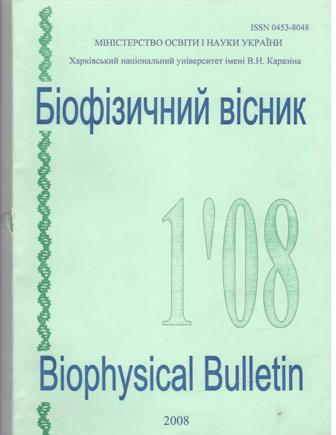Стійкість еритроцитів людини до гемолізу під дією поліпептидного антибіотика граміцидину S
Анотація
Літична активність граміцидину S (GS) лежить в основі його антибактеріальної дії і одночасно з цим обмежує системне клінічне застосування даного поліпептидного антибіотика. Синтетичні аналоги GS покликані розділити антибактеріальну і літичну активність і істотно знизити останню. Розуміння структурно-функціональних зв'язків жорсткої планарної циклічної молекули декапептиду дозволяє цілеспрямованно вести пошук нових препаратів на основі GS. Іншим важливим аспектом вдалого пошуку є правильне розуміння механізму взаємодії (GS) з плазматичними мембранами. В роботі за допомогою методу турбідиметрії досліджена концентраціонна і температурна залежності гемолізу еритроцитів людини під дією GS. Оцінена енергія активації процесу гемолізу. Проведено порівняння кислотного і GS-ідуцірованного гемолізу еритроцитів людини. Показано, що аналіз ерітрограмм GS індукованного гемолізу дозволяє отримувати додаткову інформацію про стан ліпідного бішару мембран.
Завантаження
Посилання
2. Гаузе Г.Ф. Грамицидин С и его применение. - М.: Б.и.. 1952. - 153 с.
3. Полин А.Н., Егоров Н.С. Структурно-функциональные особенности грамицидина С в связи с его антибиотической активностью // Антибиотики и химиотерапия. - 2003. - № 48(12). - С. 29-32.
4. Abraham Т., Marwaha S., Kobewka D.M. et al. The relationship between the binding to and permeabilization of phospholipid bilayer membranes by GS14dK4, a designed analog of the antimicrobial peptide gramicidin S // Biochim. Biophys. Acta. - 2007. V. 1768, N 9. - P. 2089-2098.
5. Kiricsi M., Prenner E.J., Jelokhani-Niaraki M., Lewis R.N.A.H., Hodges R.S.. McElhancy R.N. The effect of ring-size analog of the antimicrobial peptide gramicidin S on phospholipids bilayer model membranes and on the growth of Acholeplasma laidlawii В // Eur. J. Biochem. - 2002. - V. 269. P. 5911-5920
6. Prenner E.J.. Lewis R.N.A.H., McElaney R.N. The interaction of the antimicrobial peptide gramicidin S with lipid bilayer model and biological membranes // Biochimica et Biophysica Acta. - 1999. - V. 1462. - P. 210-221.
7. Биофизика клеточных популяций и надорганизменных систем: Сб.науч.тр. / Отв.ред. И.И. Гительзон. - Новосибирск: Наука, СО, 1992. - 159 с.
8. Przybylska M., Bryszewska М., Chapman I.V. Thermal properties and fluidity of human erythrocyte membranes in diabetes mellitus // Int. J. Radiat. Biol. - 1993. - V. 63, N 3. - P. 419-424.
9. Przybylska M., Bryszcwska M., Kedziora J. Thermosensitivity of red blood cells from Down's syndrome individuals // Bioelectrochemistry. - 2000. - V. 52. N 2. - P. 239-249.
10. Булгакова B.Г. Королев П.H., Петрыкина З.М. и др. Изменения оптической плотности суспензии протопластов бактерий подвергнутых действию мембрано-активных антибиотиков // Антибиотики. - 1984. - Т. 29, N 10. - С. 756-760.
Автори, які публікуються у цьому журналі, погоджуються з наступними умовами:
- Автори залишають за собою право на авторство своєї роботи та передають журналу право першої публікації цієї роботи на умовах ліцензії Creative Commons Attribution License, котра дозволяє іншим особам вільно розповсюджувати опубліковану роботу з обов'язковим посиланням на авторів оригінальної роботи та першу публікацію роботи у цьому журналі.
- Автори мають право укладати самостійні додаткові угоди щодо неексклюзивного розповсюдження роботи у тому вигляді, в якому вона була опублікована цим журналом (наприклад, розміщувати роботу в електронному сховищі установи або публікувати у складі монографії), за умови збереження посилання на першу публікацію роботи у цьому журналі.
- Політика журналу дозволяє і заохочує розміщення авторами в мережі Інтернет (наприклад, у сховищах установ або на особистих веб-сайтах) рукопису роботи, як до подання цього рукопису до редакції, так і під час його редакційного опрацювання, оскільки це сприяє виникненню продуктивної наукової дискусії та позитивно позначається на оперативності та динаміці цитування опублікованої роботи (див. The Effect of Open Access).





